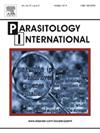Dirofilaria immitis and Dirofilaria repens infections in French working military dogs: Prevalence and factors associated with vector exposure
IF 1.5
4区 医学
Q3 PARASITOLOGY
引用次数: 0
Abstract
Dirofilaria (D.) immitis and D. repens are mosquito-borne nematodes that can cause heartworm disease and skin nodules, respectively in infected dogs. These parasites may also be responsible for minor zoonoses. Infections caused by these agents are widely distributed throughout the world and have already been reported in mainland France, especially in the south. Both parasites are associated with animal and public health concerns in France. Military working dogs are often exposed to them during their missions throughout the world, and prophylactic measures are therefore well established. To gain a better understanding of the situation among these dogs, a prevalence survey was carried out on a representative sample of 250 military working dogs. Blood samples were analyzed using a rapid test for the detection of D. immitis adult antigens, and modified Knott's test for microfilariae identification. Data on dog exposure to vectors and on their living behaviors were also collected with a survey questionnaire. For one dog (0.4 %), a positive result for D. immitis was obtained with the rapid diagnostic test, and another dog (0.4 %) was found to be positive for D. repens with the modified Knott's test. However, only D. repens infection was confirmed by polymerase chain reaction. These dogs were living in outdoor kennels, which could increase their exposure to mosquito vectors in enzootic areas, and thus to the parasites, further reinforced by their predominantly outdoor operational activities. Nevertheless, the low observed prevalences may reflect the effectiveness of stringent prevention measures in this specific population, or a generally low level of transmission in the general canine population in France—albeit insufficiently documented due to limited surveillance data—or again, limitations related to the imperfect diagnostic methods employed in this study.
法国军犬工作犬的免疫丝虫炎和重丝虫感染:流行率和与媒介暴露相关的因素
免疫Dirofilaria (D.) immitis和repens (D.)是蚊子传播的线虫,分别可在受感染的狗中引起心丝虫病和皮肤结节。这些寄生虫也可能引起轻微的人畜共患病。由这些病原体引起的感染在世界各地广泛分布,在法国大陆,特别是在南部已经有报告。在法国,这两种寄生虫都与动物和公共卫生问题有关。军事工作犬在世界各地执行任务时经常接触到它们,因此制定了良好的预防措施。为了更好地了解这些犬的情况,对250只具有代表性的军犬进行了患病率调查。使用快速检测免疫弓形虫成体抗原的方法对血样进行分析,并使用改进的Knott试验对微丝虫进行鉴定。还通过调查问卷收集了犬类接触媒介和生活行为的数据。其中一只狗(0.4%)的快速诊断试验结果为免疫弓形虫阳性,另一只狗(0.4%)的改良Knott试验结果为雷恩斯弓形虫阳性。但聚合酶链反应仅证实了D. repens感染。这些狗生活在室外犬舍中,这可能增加它们与地方性动物病媒的接触,从而增加它们与寄生虫的接触,而它们主要是在室外活动,这进一步加强了它们的接触。然而,观察到的低患病率可能反映了在这一特定人群中严格预防措施的有效性,或者反映了法国普通犬群中普遍低水平的传播——尽管由于监测数据有限而没有充分的记录——或者再次,与本研究中采用的不完善的诊断方法相关的局限性。
本文章由计算机程序翻译,如有差异,请以英文原文为准。
求助全文
约1分钟内获得全文
求助全文
来源期刊

Parasitology International
医学-寄生虫学
CiteScore
4.00
自引率
10.50%
发文量
140
审稿时长
61 days
期刊介绍:
Parasitology International provides a medium for rapid, carefully reviewed publications in the field of human and animal parasitology. Original papers, rapid communications, and original case reports from all geographical areas and covering all parasitological disciplines, including structure, immunology, cell biology, biochemistry, molecular biology, and systematics, may be submitted. Reviews on recent developments are invited regularly, but suggestions in this respect are welcome. Letters to the Editor commenting on any aspect of the Journal are also welcome.
 求助内容:
求助内容: 应助结果提醒方式:
应助结果提醒方式:


